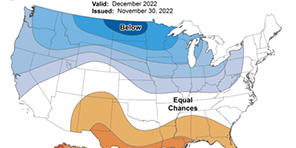By Trent Ford, Illinois State Climatologist
SPRINGFIELD, Ill. – The preliminary statewide average November temperature was 42.3 degrees, 0.6 degrees above the 1991–2020 average and tied for 45th warmest on record going back to 1895. The preliminary statewide average total November precipitation was 1.92 inches, 1.40 inches below the 1991–2020 average and the 39th driest on record statewide.
Data are provisional and may change slightly over time.
November Temperature Swings
November began with unusually warm weather across the state. A strong cold front moved through around November 11, ushering out the warmer air and replacing it with unusually cold air from Canada. The following 10 days between November 11 and the 20th were 5 to 15 degrees colder than normal. November is known for intense temperature swings as we transition from fall to winter; however, this month’s swing was particularly extreme.
For example, the average temperature in the first 10 days of the month was the 2nd highest on record in Paducah, Kentucky. The following 10 days had an average temperature that was the 3rd lowest on record. Temperatures moderated in the final 10 days of the month across the state.
Several places in the state had temperatures reach into the low to mid-80s in the first 10 days of November, including 82 degrees in Cahokia Heights and Cairo. Meanwhile, the cold air outbreak in the middle of the month brought nighttime low temperatures into the teens and single digits across the state, including 8 degrees in Monmouth and Champaign. Any place that missed out on a 28-degree hard freeze in October reached that mark multiple times in November.
November average temperatures ranged from the high 30s in northern Illinois to the low 50s in southern Illinois, within 1 degree of normal in the northern half of the state and between 1 and 3 degrees below normal in southern Illinois. The warmest spot in the state last month was Dixon Springs in Pope County with an average temperature of 46.7 degrees, and the coolest spot in the state was Elizabeth in Jo Daviess County with an average temperature of 38.7 degrees.
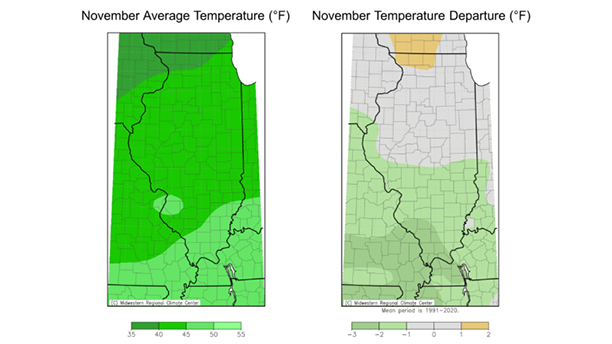
Maps of (left) November average temperature and (right) November average temperature departures from normal.
The warm start to November broke 50 daily high maximum temperature records and broke four daily high minimum temperature records last month. The subsequent cold weather broke 30 daily low maximum temperature records and broke 27 low minimum temperature records last month.
Overall, he preliminary statewide average November temperature was 42.3 degrees, 0.6 degrees above the 1991–2020 average and tied for 45th warmest on record going back to 1895.
A Mild Fall
Fall 2021 was the 10th warmest on record statewide, including the fourth warmest October on record statewide. Although some may enjoy an extension of summer, the unusually warm weather last year challenged many of the fall activities. In contrast, we enjoyed mild temperatures this fall, making for a great season to be outdoors in Illinois. September was within one degree of normal statewide, October was one to three degrees cooler than normal, and November was near to slightly cooler than normal statewide.
Overall, the statewide fall 2022 average temperature was 54.1 degrees, 0.1 degrees below the 1991–2020 normal and tied for 64th coolest on record.
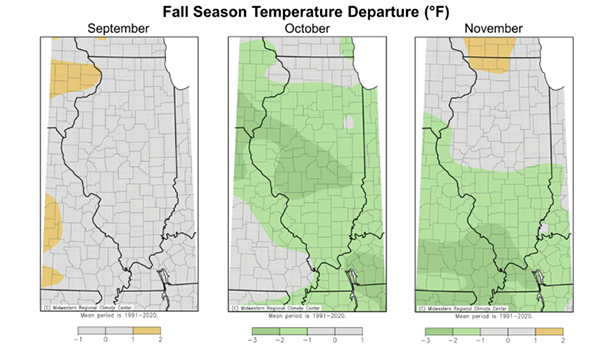
Maps show average temperature departures for September, October, and November.
Dry November Didn’t Bring Drought Help
November is typically one of our drier months outside of the winter, so we don’t expect November to make a big dent in precipitation deficits from the summer and fall. This year November played to type and continued the drier than normal weather streak for most of the state. Total November precipitation ranged from nearly four inches in northwest Illinois to less than 1.5 inches in east-central and southeast Illinois. Only the northwest sliver of the state was wetter than normal last month, while southeast Illinois was two to three inches drier than normal.
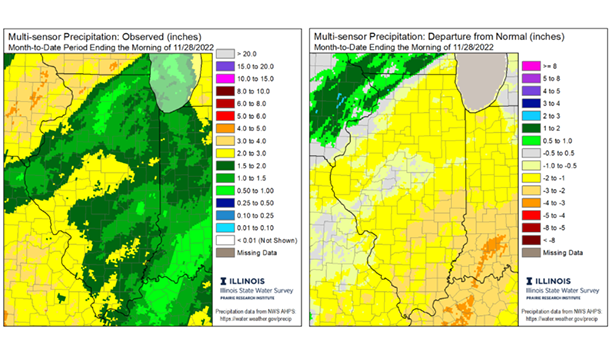
Maps show (left) total November precipitation and (right) November precipitation departure from normal.
Despite the drier weather in November, virtually all the state saw near to above normal snowfall last month. November snowfall totals ranged from over seven inches in southwest Illinois to just less than one inch in central Illinois. All areas south of Interstate 80 had above normal snowfall, while northern Illinois had just less than normal November snowfall.
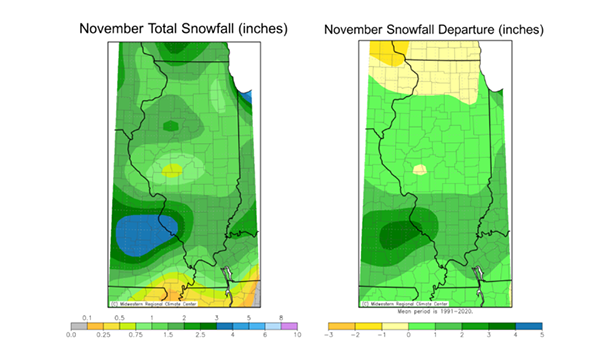
Maps show (left) total November snowfall and (right) November snowfall departure from normal.
A strong low-pressure system swung through the middle Mississippi region in mid-November and brought sometimes heavy snow to the St. Louis Metro East area. Parts of Belleville, Mascoutah, and Breese picked up between six and eight inches of snow in just a few hours. Waterloo in Monroe County had 8.4 inches of snow last month–most of which came from that one storm–making it the second snowiest November on record there (after 1980). The November snowfall in southern Illinois was not only unusually heavy, but was also abnormally early, especially in far southern Illinois. Paducah, Kentucky–just across the Ohio River from Brookport in Massac County–had its first measurable snow on November 11 this year, the third earliest on record.
Drought Continues
Outside of parts of southwest, east-central, and northwest Illinois that experienced very heavy rain in mid- to late summer, most of Illinois has been somewhat to much drier than normal since July. Long-term precipitation deficits are largest in southern Illinois, where areas from Carbondale to Metropolis have had only 50–60 percent of normal rainfall since July 1.
Unfortunately, the mild fall temperatures were accompanied by drier weather, extending drought conditions across the state. As most parts of the state were drier than normal in at least two of the three fall months, and all three months were drier than normal in southern Illinois.
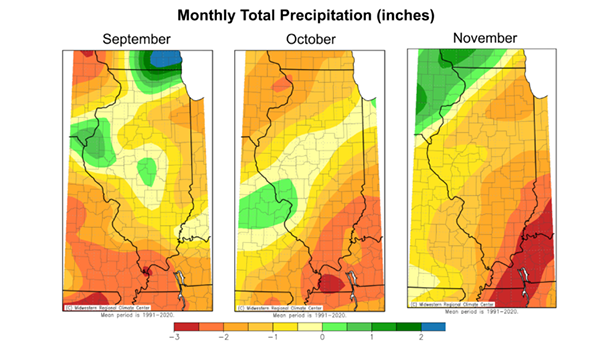
Maps show total monthly precipitation departures from normal in (left) September, (middle) October, and (right) November.
The result of the dry weather was a continuation–and in some cases, worsening–of drought conditions across the state. The latest U.S. Drought Monitor shows severe to extreme drought across southern Illinois and moderate drought in north-central and northeast Illinois. Although ecological impacts have diminished as we move closer to winter, drought impacts to hydrology have continued. These impacts include low stream, lake, and pond levels across the state and low flow on the Illinois and Mississippi Rivers.
Overall, the preliminary statewide total November precipitation was 1.92 inches, 1.40 inches below the 1991–2020 average and the 39th driest on record statewide. The 2022 fall season preliminary total precipitation was 6.84 inches, 2.58 inches below normal and the 28th driest on record since 1895.
Looking Forward to December & Winter
December is the start to climatological winter and when we typically begin to see our more interesting winter weather. The current Climate Prediction Center outlook for the month of December leans toward cooler than normal weather for the last month of the year. While the outlook leans drier than normal in northern Illinois, there are higher chances for wetter than normal weather in drought-stricken southern Illinois
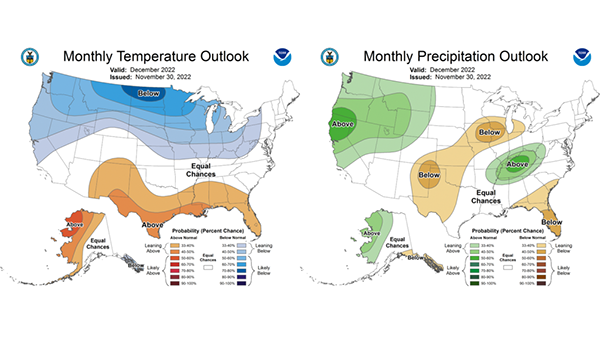
Climate Prediction Center (left) temperature and (right) precipitation outlooks for December.
Meanwhile, outlooks for the winter season, December through February, lean more into ongoing La Niña patterns, including higher chances of wetter than normal conditions in winter. If La Niña plays to type and we do see a wetter winter, it would be beneficial for removing or reducing drought across the state. With that said, previous La Niña winters tend to be “back-loaded,” meaning we don’t see the strongest signals until January and February.
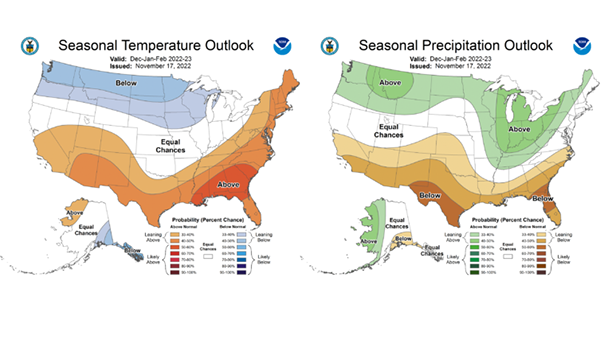
Climate Prediction Center (left) temperature and (right) precipitation outlooks for winter (December–February).

